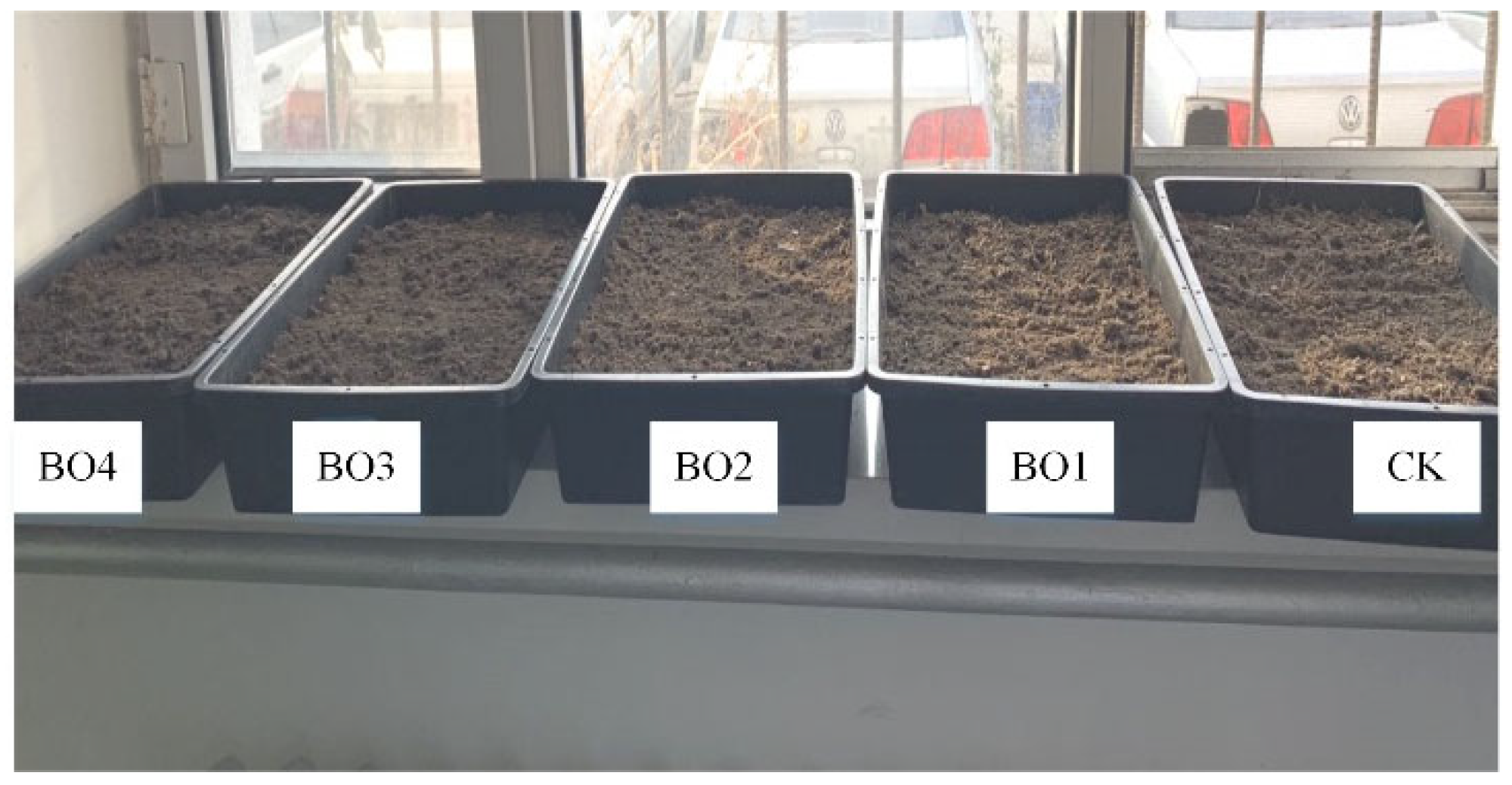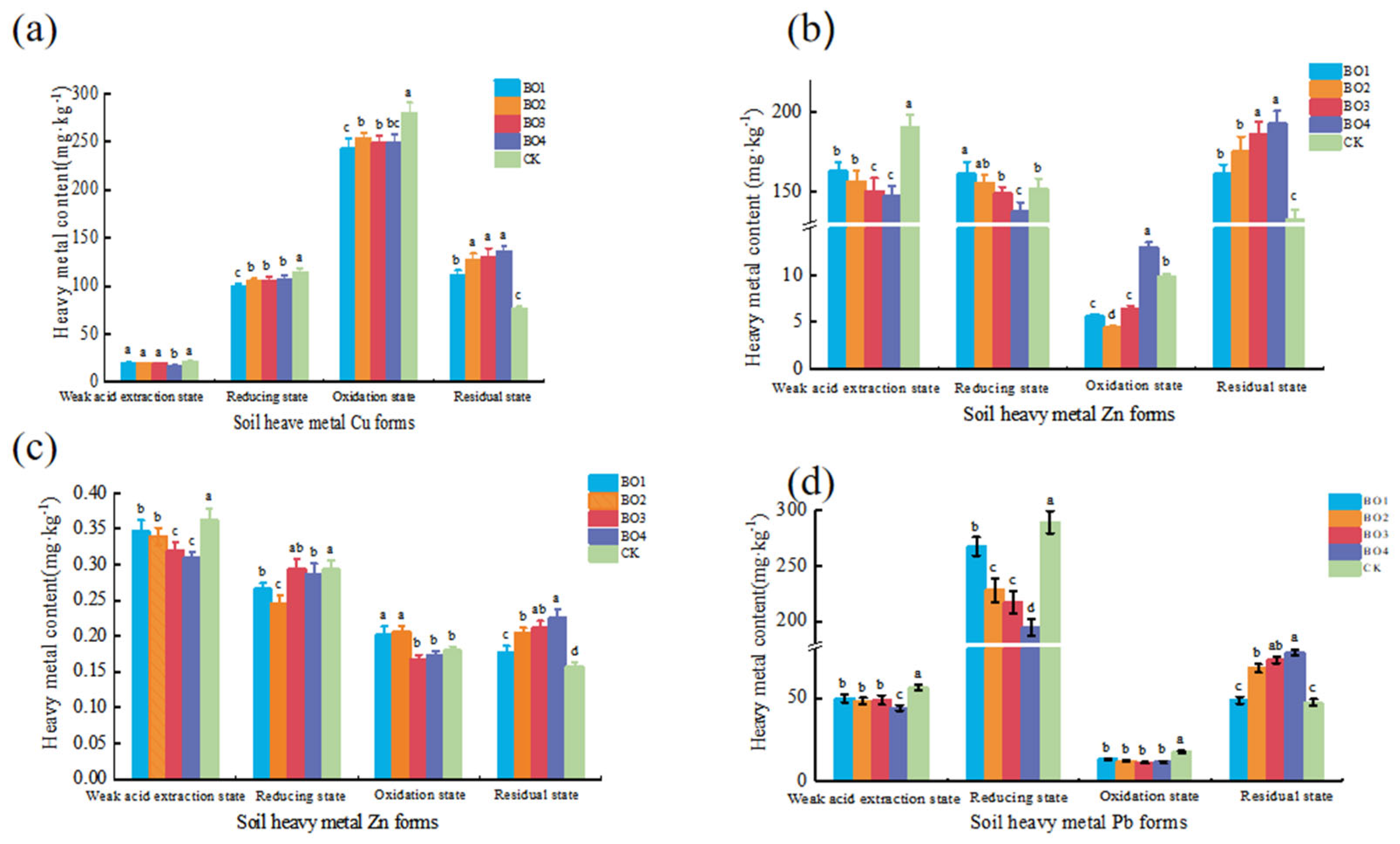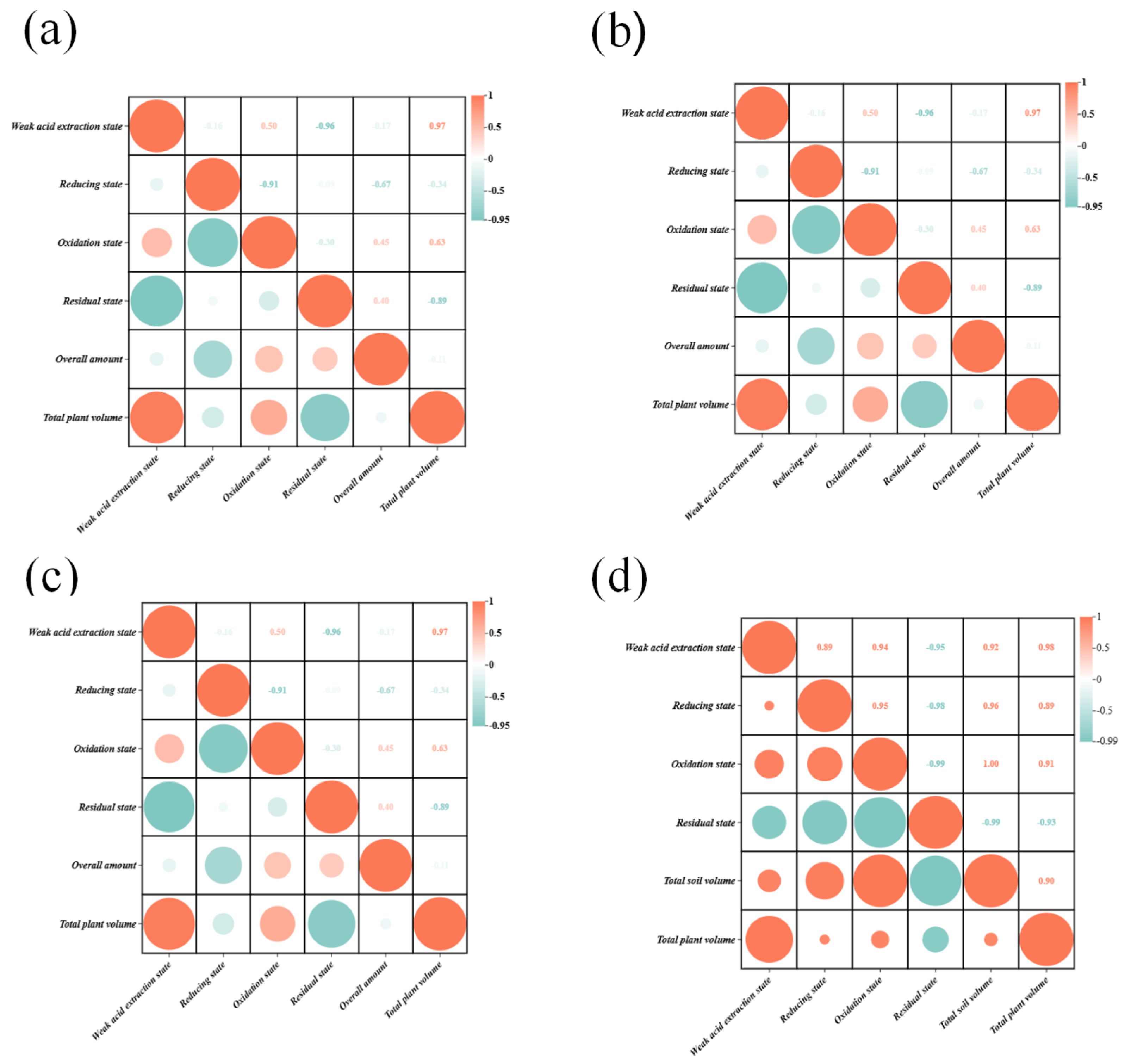Effect of Biochar-Based Organic Fertilizers on the Transport and Accumulation of Heavy Metals in Soil and Plants
Abstract
1. Introduction
2. Materials and Methods
2.1. Experimental Materials
2.2. Experimental Design
2.3. Heavy Metal Measurement Indicators and Methods
2.4. Data Processing
3. Results and Discussion
3.1. Effects on Heavy Metals Cu and Pb in Soil and Plants
3.1.1. Effect on Heavy Metal Cu in Soil and Plants
3.1.2. Effect on Heavy Metal Pb in Soil and Plants
3.2. Effect on Heavy Metal Zn in Soil and Plants
3.3. Effect on Heavy Metal Cd in Soil and Plants
3.4. Environmental Risk Assessment for Heavy Metals
4. Conclusions
Author Contributions
Funding
Institutional Review Board Statement
Informed Consent Statement
Data Availability Statement
Conflicts of Interest
References
- Zhang, Y.; Xu, Y.; Yu, X.; Li, J.; Chen, G.; Wang, S.; Xu, Y.; Xu, R.; Zhang, B.; Zhang, H. Microbial metabolism and humic acid formation in response to enhanced copper and zinc passivation during composting of wine grape pomace and pig manure. Bioresour. Technol. 2023, 384, 129226. [Google Scholar] [CrossRef] [PubMed]
- Li, N.; Li, H.; Su, G.; Chen, J. Heavy metal distribution profiles in soil and groundwater near pig farms in China. Chemosphere 2022, 294, 133721. [Google Scholar] [CrossRef]
- Luo, M.; Zhou, D.-D.; Shang, A.; Gan, R.-Y.; Li, H.-B. Influences of food contaminants and additives on gut microbiota as well as protective effects of dietary bioactive compounds. Trends Food Sci. Technol. 2021, 113, 180–192. [Google Scholar] [CrossRef]
- Zuševica, A.; Adamovičs, A.; Dūmiņš, K.; Vendiņa, V.; Žīgure, S.; Lazdina, D. Soil Fertility Improvement with Mixtures of Wood Ash and Biogas Digestates Enhances Leaf Photosynthesis and Extends the Growth Period for Deciduous Trees. Plants 2023, 12, 1152. [Google Scholar] [CrossRef]
- Qu, Y.; Miao, X.; Chen, S.; Qin, N.; Li, J.; Che, Y.; Luo, L.; Sun, Y. Novel insights into the mechanism of dynamic changes in microstructure and physicochemical properties of corn straw pretreated by ball milling and feasibility analysis of anaerobic digestion. Sci. Total Environ. 2024, 945, 173943. [Google Scholar] [CrossRef]
- Qu, Y.; Lv, X.; Qin, N.; Zhang, K.; Ding, X.; Luo, L.; Qu, J.; Sun, Y. Mechanism of ball milling pretreatment to improve the anaerobic digestion performance and energy conversion efficiency of corn straw. Fuel 2024, 366, 131409. [Google Scholar] [CrossRef]
- Helaoui, S.; Boughattas, I.; Mkhinini, M.; Chebbi, L.; Elkribi-Boukhris, S.; Alphonse, V.; Livet, A.; Banni, M.; Bousserrhine, N. Biochar amendment alleviates heavy metal phytotoxicity of Medicago sativa grown in polymetallic contaminated soil: Evaluation of metal uptake, plant response and soil properties. Plant Stress 2023, 10, 100212. [Google Scholar] [CrossRef]
- Awad, M.; El-Sayed, M.M.; Li, X.; Liu, Z.; Mustafa, S.K.; Ditta, A.; Hessini, K. Diminishing Heavy Metal Hazards of Contaminated Soil via Biochar Supplementation. Sustainability 2021, 13, 12742. [Google Scholar] [CrossRef]
- Czekała, W.; Nowak, M.; Piechota, G. Sustainable management and recycling of anaerobic digestate solid fraction by composting: A review. Bioresour. Technol. 2023, 375, 128813. [Google Scholar] [CrossRef]
- Wang, J.; Pan, J.; Ma, X.; Li, S.; Chen, X.; Liu, T.; Wang, Q.; Wang, J.J.; Wei, D.; Zhang, Z.; et al. Solid digestate biochar amendment on pig manure composting: Nitrogen cycle and balance. Bioresour. Technol. 2022, 349, 126848. [Google Scholar] [CrossRef]
- Tang, Y.; Wang, C.; Holm, P.E.; Hansen, H.C.B.; Brandt, K.K. Impacts of biochar materials on copper speciation, bioavailability, and toxicity in chromated copper arsenate polluted soil. J. Hazard. Mater. 2023, 459, 132067. [Google Scholar] [CrossRef]
- Zhao, W.; Yang, H.; He, S.; Zhao, Q.; Wei, L. A review of biochar in anaerobic digestion to improve biogas production: Performances, mechanisms and economic assessments. Bioresour. Technol. 2021, 341, 125797. [Google Scholar] [CrossRef]
- Behera, S.; Samal, K. Sustainable approach to manage solid waste through biochar assisted composting. Energy Nexus 2022, 7, 100121. [Google Scholar] [CrossRef]
- Li, J.; Xia, C.; Cheng, R.; Lan, J.; Chen, F.; Li, X.; Li, S.; Chen, J.; Zeng, T.; Hou, H. Passivation of multiple heavy metals in lead–zinc tailings facilitated by straw biochar-loaded N-doped carbon aerogel nanoparticles: Mechanisms and microbial community evolution. Sci. Total Environ. 2022, 803, 149866. [Google Scholar] [CrossRef]
- Debode, J.; Ebrahimi, N.; D’Hose, T.; Cremelie, P.; Viaene, N.; Vandecasteele, B. Has compost with biochar added during the process added value over biochar or compost to increase disease suppression? Appl. Soil Ecol. 2020, 153, 103571. [Google Scholar] [CrossRef]
- Pastorelli, R.; Valboa, G.; Lagomarsino, A.; Fabiani, A.; Simoncini, S.; Zaghi, M.; Vignozzi, N. Recycling Biogas Digestate from Energy Crops: Effects on Soil Properties and Crop Productivity. Appl. Sci. 2021, 11, 750. [Google Scholar] [CrossRef]
- Liang, W.; Wang, G.; Peng, C.; Tan, J.; Wan, J.; Sun, P.; Li, Q.; Ji, X.; Zhang, Q.; Wu, Y.; et al. Recent advances of carbon-based nano zero valent iron for heavy metals remediation in soil and water: A critical review. J. Hazard. Mater. 2022, 426, 127993. [Google Scholar] [CrossRef] [PubMed]
- Bat, L.; Yardım, Ö.; Öztekin, A.; Arıcı, E. Assessment of heavy metal concentrations in Scophthalmus maximus (Linnaeus, 1758) from the Black Sea coast: Implications for food safety and human health. J. Hazard. Mater. Adv. 2023, 12, 100384. [Google Scholar] [CrossRef]
- Anițaș, S.; Coman, M.; Cioruța, V.B. Some Considerations Regarding the Presence of Heavy Metals in Soil and the Human Body. Asian Soil Res. J. 2020, 39–46. [Google Scholar] [CrossRef]
- Li, K.; Yang, H.; Yuan, X.; Zhang, M. Recent developments of heavy metals detection in traditional Chinese medicine by atomic spectrometry. Microchem. J. 2021, 160, 105726. [Google Scholar] [CrossRef]
- Custodio, M.; Peñaloza, R.; Cuadrado, W.; Ochoa, S.; Álvarez, D.; Chanamé, F. Data on the detection of essential and toxic metals in soil and corn and barley grains by atomic absorption spectrophotometry and their effect on human health. Chem. Data Collect. 2021, 32, 100650. [Google Scholar] [CrossRef]
- Yuan, X.; Xiong, T.; Wang, H.; Wu, Z.; Jiang, L.; Zeng, G.; Li, Y. Immobilization of heavy metals in two contaminated soils using a modified magnesium silicate stabilizer. Environ. Sci. Pollut. Res. 2018, 25, 32562–32571. [Google Scholar] [CrossRef]
- Gonzaga, M.I.S.; Mackowiak, C.; de Almeida, A.Q.; Wisniewski, A.; de Souza, D.F.; Lima, I.d.S.; de Jesus, A.N. Assessing biochar applications and repeated Brassica juncea L. production cycles to remediate Cu contaminated soil. Chemosphere 2018, 201, 278–285. [Google Scholar] [CrossRef]
- Ahmad, K.; Khan, Z.I.; Yasmin, S.; Ashfaq, A.; Noorka, I.R.; Akram, N.A.; Shad, H.A.; Hussain, A.; Arshad, F.; Sher, M.; et al. Contamination of soil and carrots irrigated with different sources of water in Punjab, Pakistan. Environ. Earth Sci. 2016, 75, 426. [Google Scholar] [CrossRef]
- Twining, J.R.; Payne, T.E.; Itakura, T. Soil-water distribution coefficients and plant transfer factors for 134Cs, 85Sr and 65Zn under field conditions in tropical Australia. J. Environ. Radioact. 2004, 71, 71–87. [Google Scholar] [CrossRef]
- Lu, H.; Yang, Y.; Huang, K.; Huang, G.; Hu, S.; Pan, D.; Liu, T.; Li, X. Transformation kinetics of exogenous lead in an acidic soil during anoxic-oxic alteration: Important roles of phosphorus and organic matter. Environ. Pollut. 2023, 335, 122271. [Google Scholar] [CrossRef] [PubMed]
- Li, X.X.; Huang, S.; McBride, M.B. Rhizosphere effect on Pb solubility and phytoavailability in Pb-Contaminated soils. Environ. Pollut. 2021, 268, 115840. [Google Scholar] [CrossRef] [PubMed]
- Jiang, T.-Y.; Jiang, J.; Xu, R.-K.; Li, Z. Adsorption of Pb(II) on variable charge soils amended with rice-straw derived biochar. Chemosphere 2012, 89, 249–256. [Google Scholar] [CrossRef]
- Luo, L.; Shen, Y.; Liu, J.; Zeng, Y. Investigation of Pb species in soils, celery and duckweed by synchrotron radiation X-ray absorption near-edge structure spectrometry. Spectrochim. Acta Part B-At. Spectrosc. 2016, 122, 40–45. [Google Scholar] [CrossRef]
- Wang, C.; Yang, Z.; Yuan, X.; Browne, P.; Chen, L.; Ji, J. The influences of soil properties on Cu and Zn availability in soil and their transfer to wheat (Triticum aestivum L.) in the Yangtze River delta region, China. Geoderma 2013, 193, 131–139. [Google Scholar] [CrossRef]
- Karami, N.; Clemente, R.; Moreno-Jiménez, E.; Lepp, N.W.; Beesley, L. Efficiency of green waste compost and biochar soil amendments for reducing lead and copper mobility and uptake to ryegrass. J. Hazard. Mater. 2011, 191, 41–48. [Google Scholar] [CrossRef]
- Uchimiya, M.; Chang, S.; Klasson, K.T. Screening biochars for heavy metal retention in soil: Role of oxygen functional groups. J. Hazard. Mater. 2011, 190, 432–441. [Google Scholar] [CrossRef] [PubMed]
- Cui, L.; Li, L.; Zhang, A.; Pan, G.; Bao, D.; Chang, A. Biochar amendment greatly reduces rice Cd uptake in a contaminated paddy soil: A two-year field experiment. Bioresources 2011, 6, 2605–2618. [Google Scholar] [CrossRef]
- Rafique, M.; Ortas, I.; Rizwan, M.; Sultan, T.; Chaudhary, H.J.; Işik, M.; Aydin, O. Effects of Rhizophagus clarus and biochar on growth, photosynthesis, nutrients, and cadmium (Cd) concentration of maize (Zea mays) grown in Cd-spiked soil. Environ. Sci. Pollut. Res. 2019, 26, 20689–20700. [Google Scholar] [CrossRef] [PubMed]
- Qian, L.; Mei, C.; Li, T.; Luo, W.; Liu, W.; Chen, M.; Yang, X.; Li, X.; Cheng, B.; Ma, H. A versatile biochar fertilizer used for adsorption of heavy metals and enhancement of plant growth in metal contaminated soil. Environ. Technol. Innov. 2024, 36, 103743. [Google Scholar] [CrossRef]
- Hu, W.; Zhang, Y.; Rong, X.; Zhou, X.; Fei, J.; Peng, J.; Luo, G. Biochar and organic fertilizer applications enhance soil functional microbial abundance and agroecosystem multifunctionality. Biochar 2024, 6, 3. [Google Scholar] [CrossRef]



| CK | Biochar-based organic fertilizer with 0.0% biochar additions |
| BO1 | Biochar-based organic fertilizer with 2.5% biochar additions |
| BO2 | Biochar-based organic fertilizer with 5.0% biochar additions |
| BO3 | Biochar-based organic fertilizer with 7.5% biochar additions |
| BO4 | Biochar-based organic fertilizer with 10% biochar additions |
| Norm | Soil | BO1 | BO2 | BO3 | BO4 |
|---|---|---|---|---|---|
| TC (g·kg−1) | 13.23 ± 0.54 | 248.18 ± 12.34 | 255.44 ± 16.74 | 237.12 ± 10.24 | 252.58 ± 8.64 |
| TN (g·kg−1) | 1.59 ± 0.07 | 16.81 ± 0.62 | 16.75 ± 0.77 | 15.85 ± 0.64 | 16.94 ± 0.88 |
| TP (g·kg−1) | 0.58 ± 0.03 | 17.41 ± 0.06 | 19.05 ± 0.08 | 18.80 ± 0.07 | 18.76 ± 0.04 |
| TK (g·kg−1) | 2.75 ± 0.12 | 17.20 ± 0.07 | 18.84 ± 0.05 | 18.60 ± 0.10 | 18.65 ± 0.08 |
| pH | 6.48 ± 0.12 | 8.20 ± 0.02 | 8.06 ± 0.05 | 8.04 ± 0.03 | 8.12 ± 0.02 |
| Conductivity (mS·cm−1) | 5.46 ± 0.18 | 1.11 ± 0.02 | 1.18 ± 0.04 | 1.12 ± 0.03 | 1.20 ± 0.02 |
| Organic matter (per cent) | 2.28 ± 0.10 | 48.36 ± 1.46 | 47.30 ± 1.25 | 46.10 ± 1.62 | 45.34 ± 1.63 |
| Cu (mg·kg−1) | 8.35 ± 0.26 | 59.55 ± 2.20 | 60.78 ± 2.78 | 61.45 ± 3.24 | 57.41 ± 1.58 |
| Zn (mg·kg−1 ) | 10.62 ± 3.58 | 59.96 ± 2.42 | 61.57 ± 1.78 | 59.19 ± 2.05 | 59.02 ± 1.34 |
| Cd (mg·kg−1) | - | 0.46 ± 0.01 | 0.51 ± 0.03 | 0.50 ± 0.02 | 0.48 ± 0.02 |
| Pb (mg·kg−1) | 3.95 ± 0.54 | 5.65 ± 0.24 | 6.34 ± 0.15 | 5.07 ± 0.13 | 3.90 ± 0.18 |
| Test | Cu Content in the Ground (mg·kg−1) | Subterranean Cu Content (mg·kg−1) | Ground BF | Subterranean BF | TF |
|---|---|---|---|---|---|
| BO1 | 18.50 ± 0.58 b | 70.29 ± 3.85 ab | 0.0377 b | 0.1431 b | 0.2632 b |
| BO2 | 18.02 ± 0.74 b | 68.06 ± 1.76 b | 0.0370 b | 0.1396 c | 0.2648 b |
| BO3 | 16.91 ± 0.68 c | 66.20 ± 4.15 bc | 0.0347 c | 0.1360 d | 0.2554 c |
| BO4 | 16.02 ± 0.71 c | 63.81 ± 2.17 c | 0.0330 d | 0.1213 e | 0.2511 c |
| CK | 19.98 ± 0.62 a | 72.80 ± 3.28 a | 0.0399 a | 0.1453 a | 0.2744 a |
| Test | Pb Content in the Ground (mg·kg−1) | Subterranean Pb Content (mg·kg−1) | Ground BF | Subterranean BF | TF |
|---|---|---|---|---|---|
| BO1 | 6.04 ± 0.28 b | 69.01 ± 3.07 b | 0.0123 b | 0.1409 b | 0.0876 b |
| BO2 | 4.71 ± 0.17 c | 57.62 ± 2.88 c | 0.0097 c | 0.1184 c | 0.0817 c |
| BO3 | 3.78 ± 0.15 d | 49.68 ± 2.62 d | 0.0078 d | 0.1028 d | 0.0760 d |
| BO4 | 3.58 ± 0.21 d | 46.09 ± 1.78 d | 0.0074 d | 0.0957 d | 0.0776 d |
| CK | 6.83 ± 0.27 a | 74.60 ± 2.65 a | 0.0139 a | 0.1514 a | 0.0915 a |
| Test | Zn Content in the Ground (mg·kg−1) | Subterranean Zn Content (mg·kg−1) | Ground BF | Subterranean BF | TF |
|---|---|---|---|---|---|
| BO1 | 100.29 ± 4.23 b | 181.51 ± 7.28 b | 0.2043 b | 0.3699 b | 0.5525 b |
| BO2 | 75.47 ± 3.17 c | 141.58 ± 8.93 c | 0.1535 c | 0.2879 c | 0.5331 b |
| BO3 | 66.35 ± 2.08 cd | 119.26 ± 4.85 d | 0.1349 c | 0.2424 cd | 0.5563 b |
| BO4 | 54.91 ± 2.76 d | 98.85 ± 3.64 d | 0.1121 c | 0.2018 d | 0.5554 b |
| CK | 125.65 ± 5.84 a | 204.98 ± 8.17 a | 0.2517 a | 0.4106 a | 0.6130 a |
| Test | Cd Content in the Ground (mg·kg−1) | Subterranean Cd Content (mg·kg−1) | Ground BF | Subterranean BF | TF |
|---|---|---|---|---|---|
| BO1 | 0.04 ± 0.002 a | 0.08 ± 0.003 ab | 0.0413 b | 0.0831 b | 0.4970 b |
| BO2 | 0.04 ± 0.001 a | 0.08 ± 0.004 b | 0.0411 b | 0.0795 c | 0.5152 b |
| BO3 | 0.03 ± 0.001 b | 0.06 ± 0.002 c | 0.0333 c | 0.0574 d | 0.5796 b |
| BO4 | 0.03 ± 0.001 b | 0.04 ± 0.001 d | 0.0293 d | 0.0410 e | 0.7145 a |
| CK | 0.05 ± 0.002 a | 0.09 ± 0.003 a | 0.0451 a | 0.0893 a | 0.5073 b |
| Test | Individual Potential Ecological Risk Factor ER | Potential Ecological Risk Index RI | |||
|---|---|---|---|---|---|
| Cu | Zn | Cd | Pb | ||
| BO1 | 17.07 b | 2.04 b | 138.31 b | 12.65 b | 170.07 b |
| BO2 | 15.64 c | 1.80 c | 115.76 c | 10.39 c | 143.59 c |
| BO3 | 14.55 c | 1.64 cd | 110.38 c | 8.21 d | 134.78 c |
| BO4 | 14.22 c | 1.54 d | 102.08 c | 7.19 d | 125.03 c |
| CK | 23.94 a | 2.41 a | 154.81 a | 17.55 a | 198.71 a |
Disclaimer/Publisher’s Note: The statements, opinions and data contained in all publications are solely those of the individual author(s) and contributor(s) and not of MDPI and/or the editor(s). MDPI and/or the editor(s) disclaim responsibility for any injury to people or property resulting from any ideas, methods, instructions or products referred to in the content. |
© 2025 by the authors. Licensee MDPI, Basel, Switzerland. This article is an open access article distributed under the terms and conditions of the Creative Commons Attribution (CC BY) license (https://creativecommons.org/licenses/by/4.0/).
Share and Cite
Qu, J.; Wang, F.; Qi, X.; Che, S.; Che, Y.; Li, J.; Wei, Z. Effect of Biochar-Based Organic Fertilizers on the Transport and Accumulation of Heavy Metals in Soil and Plants. Fermentation 2025, 11, 48. https://doi.org/10.3390/fermentation11020048
Qu J, Wang F, Qi X, Che S, Che Y, Li J, Wei Z. Effect of Biochar-Based Organic Fertilizers on the Transport and Accumulation of Heavy Metals in Soil and Plants. Fermentation. 2025; 11(2):48. https://doi.org/10.3390/fermentation11020048
Chicago/Turabian StyleQu, Jingbo, Fuxin Wang, Xiaopei Qi, Shaolong Che, Yuchen Che, Jiangnan Li, and Zimin Wei. 2025. "Effect of Biochar-Based Organic Fertilizers on the Transport and Accumulation of Heavy Metals in Soil and Plants" Fermentation 11, no. 2: 48. https://doi.org/10.3390/fermentation11020048
APA StyleQu, J., Wang, F., Qi, X., Che, S., Che, Y., Li, J., & Wei, Z. (2025). Effect of Biochar-Based Organic Fertilizers on the Transport and Accumulation of Heavy Metals in Soil and Plants. Fermentation, 11(2), 48. https://doi.org/10.3390/fermentation11020048






